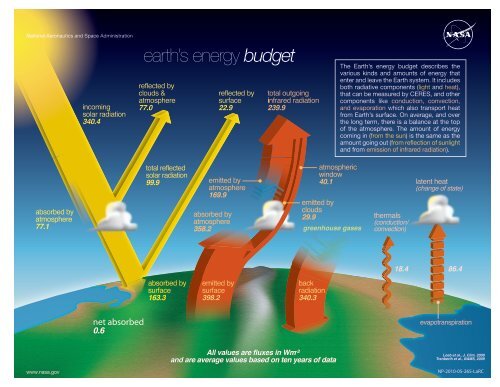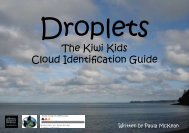NP-2010-05-265-LaRC
NP-2010-05-265-LaRC
NP-2010-05-265-LaRC
- No tags were found...
You also want an ePaper? Increase the reach of your titles
YUMPU automatically turns print PDFs into web optimized ePapers that Google loves.
<strong>NP</strong>-<strong>2010</strong>-<strong>05</strong>-<strong>265</strong>-<strong>LaRC</strong>
The Earth’s Energy BudgetThe energy budget diagram on the front shows our best understanding of energy flows intoand away from the Earth. It is based on the work of many scientists over more than 100 years,with the most recent measurements from the Clouds and the Earth’s Radiant Energy System(CERES; http://science.larc.nasa.gov/ceres/) satellite instrument providing high accuracy dataof the radiation components (reflected solar and emitted infrared radiation fluxes).This energy balance determines the climate of the Earth.Our understanding of these energy flows will continue to evolve as scientists obtain a longerand longer record using new and better instruments (http://clarreo.larc.nasa.gov/).Units:Energy fluxes are measured as Watts per square meter.Watt: a standard unit of power.Joule: a standard unit of energy1 Watt = 1 Joule / secDid you know?National Science Education Standards - http://www.nap.edu/html/nses/Content Standard D: Earth and Space Science: Energy in the earth systemContent Standard F: Science in Personal and Social Perspectives: Science and technology in local,national, and global challengesNational Council of Teachers of Mathematics Standards (grades 9-12) – http://standards.nctm.org/Number and Operations: Understand numbers, ways of representing numbers…Measurement: Understand measurable attributes of objects and the units, systems, …Data Analysis and Probability: Develop and evaluate inferences and predictions …Connections: Recognize and apply mathematics in contexts outside of mathematics.Representation: Use representations to model and interpret physical…AAAS Benchmarks (grades 9-12) - http://www.project2061.org/publications/bsl/online/The Physical Setting: Weather and ClimateTransfer of thermal energy between the atmosphere and the land or … 4B/H2Greenhouse gases in the atmosphere... 4B/H4Climatic conditions result from … 4B/H5The earth's climates have changed in the past, are currently changing, and are expected to changein the future… 4B/H6Climate Literacy Framework Principles - http://climateliteracynow.org/Principle 3: The Sun is the primary source of energy for the climate system.Principle 4: Earth’s weather and climate systems are the result of complex interactions.Principle 6: Evidence indicates human activities re impacting the climateYou can find more information, resources, and activities on this concept at:http://science-edu.larc.nasa.gov/energy_budgetAdditional information sections available on the reverse side of the large poster





